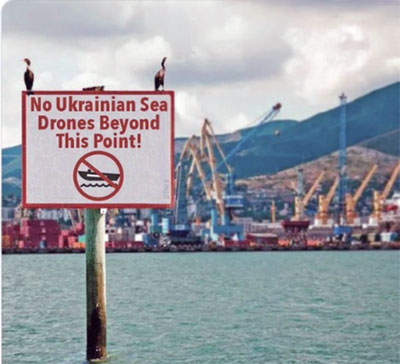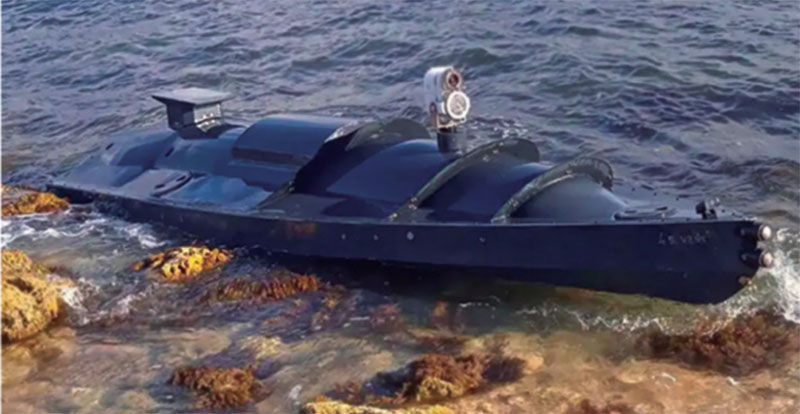Kamikaze sea drones can transform maritime warfare
RAdm. P Ashokan (retd)
On 3 March 2024, Sergei Kotov, a 1,300 tonne patrol ship of the Black Sea Fleet became the fifth ship to be sunk by kamikaze sea drones of the Ukrainian Navy, besides a number of other ships which sustained varying degrees of damage, ever since the Ukrainians commenced their sea drone campaign in October 2022. These drones are a Ukrainian innovation, after the Russians strengthened their anti-air defences, post the loss of their cruiser Moskva on 13 April 2022. The ingenuity of sea drones is credited to Ivan Volodymyrovych, a brigadier general in the Security Service of Ukraine (SBU), whose idea it was, to mount a Starlink terminal on small boats and remotely explode them.
These drones are the unmanned version of the explosive-laden boat that crashed into USS Cole on 12 October 2000, or the suicide boats used by Tamil Tigers during the Eelam War. With a length of about six metres, a breadth of two metres and weighing one tonne, it is slightly bigger than a modern heavy-weight torpedo. It would be a misnomer to refer to these drones as uncrewed surface crafts (USVs). USVs are generally larger and used for a wide spectrum of naval operations, such as mine hunting, surveillance and reconnaissance, anti-submarine warfare and strike operations. Sea drones can be aptly categorised as loitering munitions, which transit to the objective area and patrol the area at a low speed looking for targets, before identifying, selecting and attacking them. While Kamikaze air drones have been around since the 2010s, this is the first time sea drones have been used so successfully.
 Capability
Capability
There are two versions of sea drones in service with Ukraine, the smaller size Magura V5 and the bigger Sea Baby which is used for bigger platforms and fixed installations. They reportedly have an endurance of 1,000 kilometres at a speed of 10 knots. This is an exponential increase over the ranges of modern air-breathing torpedoes which have an endurance of 48-80 kilometres at a speed of 35-50 knots. Even if allowance is made for the higher underwater resistance faced by a torpedo, the figure looks highly exaggerated. On the other hand, it is a fact that the Sea Baby drone has struck Kerch Bridge which is about 400 miles (or 700 km) away from Odessa. It is very unlikely that they could have been launched from ships or elsewhere.
Magura carries about 200 kilograms of explosive (about the same as a torpedo) and Sea Baby around 800 kilograms. These drones have an impressive sensor and communication suite comprising satellite assisted navigation and autopilot, multi redundant satellite communication, terminal targeting via HD video streaming of electro-optical and infrared camera images relayed from the drone to the command post hundreds of miles away. The latest addition to Sea Baby is a six tube thermobaric launcher, which dispenses an aerosol cloud of inflammable gas, liquid or powdered explosive, possibly for self-defence or to magnify the effect of the impact on the target. The cost of sea drones as per open source information is USD 300,000 whereas the cost of a modern heavyweight torpedo is upwards of USD 3 million, ten times more.

Learning from Initial Fiasco
The first generation of sea drones was a private-public development with the customer being Ukraine’s Defence Intelligence. The first drone squad was ready in September 2022, and they were put into action soon thereafter. On the night of 16–17 September 2022, a swarm of sea drones were despatched into the Bay of Sevastopol. While the swarm was 70 kilometres away from the flagship Admiral Makarov, Elon Musk disabled the Starlink satellites which were being used to control the drones. In spite of intervention by the Ukrainian deputy prime minister, Musk did not relent. Due to this experience, the developers enhanced the communication suite to provide multiple communication channels.
The First Taste of Success
In the next attack on 28–29 October 2022, a seven-drone swarm was deployed. Three were directed south at Admiral Makarov, the second time and the remaining four into Sevastopol Harbour. In spite of Makarov being underway, one of the drones hit her and disabled her engines. The second group encountered heavy fire from the shore but managed to hit Ivan Golubets, a Russian minesweeper, and some oil stations ashore. The Russians jammed the GPS and communication channels, but the direct optical channel worked and for the first time, sea drones were successfully directed towards their target from hundreds of miles away. The lesson from the failure of September 2022 was well learnt and sea drones earned their spurs in combat. Over the next year and half and to this day, sea drones have proved to be scourge for the Black Sea Fleet, hitting over a dozen ships and shore installations and sinking five ships.

You must be logged in to view this content.

